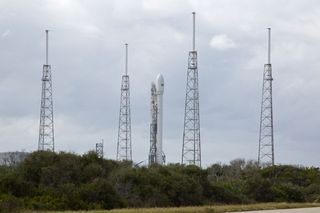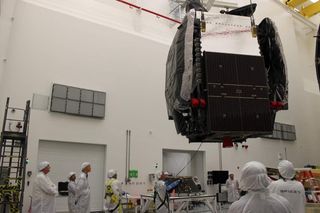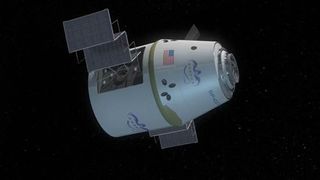SpaceX Delays Milestone Commercial Satellite Launch Due to Technical Glitch

The private spaceflight company SpaceX delayed the launch of its first commercial communications satellite mission Monday (Nov. 25) due to an unspecified technical glitch with the flight's Falcon 9 rocket.
SpaceX aimed to launch the Falcon 9 rocket at 5:37 p.m. EST (0027 Nov. 27 GMT) from the Cape Canaveral Air Force Station in Florida to send the huge SES-8 communications satellite into orbit for its customer, the satellite operator SES World Skies. But apparent glitches with the rocket pushed the liftoff time back by nearly an hour before an issue on the Falcon 9's first stage force SpaceX to call off the launch attempt.
"We observed unexpected readings with the first stage liquid oxygen system so we decided to investigate," SpaceX officials said in a statement. "The launch vehicle and satellite are in great shape and we are looking forward to the next launch opportunity on Thursday at 5:38 p.m. Eastern time (0038 Nov. 28 GMT)." [Photos: SpaceX's improved Falcon 9 rocket soars on 1st flight]

SpaceX officials said they won't try to launch until Thursday (Nov 28) due to the Federal Aviation Administration, which wanted to avoid shutting down commercial air traffic along the Florida coast during the busy Thanksgiving holiday travel period to support to the launch, according to CBS News.
Monday's launch try marked SpaceX's first attempt to launch its upgraded Falcon 9 rocket from its Florida launching site. Known as the Falcon 9 version 1.1, the 224.4-foot (68.4 meters) rocket booster includes a series of enhancements over SpaceX's baseline Falcon 9 booster, such as a circular "Octaweb" first-stage engine arrangement, triple-redundancy avionics and a larger payload fairing 17 feet (5.1 meters) wide and tall enough to fit a bus inside.
The upcoming launch will mark SpaceX's first entry into the market of large commercial satellite launches. The SES-8 satellite is a 6,918-lb. (3,137 kilograms) high-definition communications satellite destined for a transfer orbit that soars flies 183 miles (295 kilometers) above Earth at its nearest point and more than 49,709 miles (80,000 km) at its highest. The SES-8 satellite is hybrid Ku-and Ka-band spacecraft designed to provide high-definition telecommunications services to customers across the South Asia and Pacific region.
The Falcon 9 v1.1 rocket made its debut launch on Sept. 29, when it lofted the Canadian Space Agency's space weather monitoring satellite CASSIOPE into orbit from a pad at California's Vandenberg Air Force Station. While that mission successfully delivered the CASSIOPE into its intended orbit, an attempt to restart the upgraded Falcon 9 rocket's second stage engine failed due to a frozen igniter fluid line.
Get the Space.com Newsletter
Breaking space news, the latest updates on rocket launches, skywatching events and more!
The ability to restart the second stage engine is key to delivering the SES-8 satellite into its intended geostationary transfer orbit. SpaceX officials said they added more insulation to the affected fluid line to prevent the glitch from occurring again.

SpaceX is also developing a manned version of the Dragon spacecraft and is competing with other spaceflight firms to ferry astronauts to and from the International Space Station using the commercial space capsule.
Visit SPACE.com for updates on the SpaceX next-generation Falcon 9 rocket launch. SPACE.com partner Spaceflight now is also offering updates via its SpaceX Mission Status Center, which will also include a launch webcast.
Email Tariq Malik at tmalik@space.com or follow him @tariqjmalik and Google+. Follow us @Spacedotcom, Facebook and Google+. Original article on SPACE.com.
Join our Space Forums to keep talking space on the latest missions, night sky and more! And if you have a news tip, correction or comment, let us know at: community@space.com.

Tariq is the Editor-in-Chief of Space.com and joined the team in 2001, first as an intern and staff writer, and later as an editor. He covers human spaceflight, exploration and space science, as well as skywatching and entertainment. He became Space.com's Managing Editor in 2009 and Editor-in-Chief in 2019. Before joining Space.com, Tariq was a staff reporter for The Los Angeles Times covering education and city beats in La Habra, Fullerton and Huntington Beach. In October 2022, Tariq received the Harry Kolcum Award for excellence in space reporting from the National Space Club Florida Committee. He is also an Eagle Scout (yes, he has the Space Exploration merit badge) and went to Space Camp four times as a kid and a fifth time as an adult. He has journalism degrees from the University of Southern California and New York University. You can find Tariq at Space.com and as the co-host to the This Week In Space podcast with space historian Rod Pyle on the TWiT network. To see his latest project, you can follow Tariq on Twitter @tariqjmalik.
